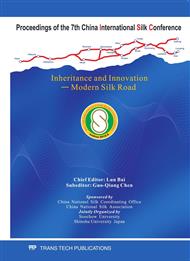p.469
p.474
p.480
p.485
p.490
p.496
p.500
p.504
p.509
Analysis on Warp’s Frictional Movement in the Heald Eye during Weaving Process
Abstract:
Currently the abrasion and breakage of warp during the weaving process have become the key issue in high-speed weaving of non-shuttle looms. According to the experiment, the heald frame is the main zone where warp abrades. With the multiple effects of shedding and beating up, warp will make a frictional movement every time one weft is weaved, no matter which opening mode is used. These frequent frictional movements will cause warp’s surface damage, which leads to breakage. Therefore warp’s frequent frictional movement in the heald eye is the main factor causing warp’s breakage. By theoretically analyzing warp’s front and back elongation and tension while beating up, this paper establishes the formula of warp’s movement in the heald eye, and discusses the effect of weaving parameters on this movement, such as looming tension, warp line, opening time and geometric shedding size. This provides theoretical basis for solving the frictional issue reasonably. According to the result, by forming the shed with big tension, high back-rest, late shedding, long shed, fast opening and slow closing, the frictional movement of warp in the heald eye can be reduced during the weaving process. In this way, warp’s excessive abrasion can be avoided and its breakage will be lowered, so as to improve weaving efficiency.
Info:
Periodical:
Pages:
490-495
Citation:
Online since:
January 2011
Authors:
Keywords:
Price:
Сopyright:
© 2011 Trans Tech Publications Ltd. All Rights Reserved
Share:
Citation:


